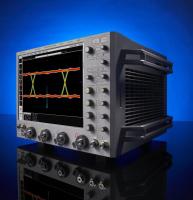| www.tmatlantic.com
Test & Soldering Equipment On-line Store |
|
D.E.V.I.C.E. (Wiki)Calculators Services |
|||||
Agilent Infiniium oscilloscope reaches 63-GHz-bandwidth
05/09/2012 With two of its four channels active and the maximum 2 Gsamples/active channel acquisition-memory installed, Agilent's new Infiniium 96204Q real-time-sampling DSO takes 160 Gsamples/sec on each active channel and, at that sampling rate, captures records of 12.5-msec duration. The rms JNF (jitter noise floor) is 75 fsec. Currently, only one other family of scopes offers similar performance. Units in LeCroy's 3-1/2-month old LabMaster 10 Zi family sample at the same rates, have just 4.5% lower maximum -3-db bandwidth, have 10% longer 20-to-80% rise time, deliver a 33% greater JNF, and accommodate only half as much acquisition memory. However, if you use all four channels-the mode that allows the fastest members of each family to acquire 80G samples/sec simultaneously on all channels-the 96204Q's bandwidth drops to 33 GHz, whereas that of a well-equipped 10 Zi is 36-GHz. Moreover, LeCroy is unique in enabling users to select the shape of the scope's high-frequency response (rolloff). A significant difference between the two families is packaging: the Agilent units are four-channel oscilloscopes that you can use as two-channel instruments to obtain maximum bandwidth and minimum rise-time; the LeCroy products are modular oscilloscope systems, which in the 2/4-channel configuration, consist of two modular units that, together, are a bit larger than one 96204Q. The LeCroy system accommodates as many as five acquisition modules and, thus, expands to 20 channels at 36-GHz bandwidth or 10 channels at 60 GHz. In this configuration, all channels' waveforms are synchronized and appear on one 15+-in.-diagonal LCD. Agilent allows you to combine four oscilloscopes into a system that accommodates 16 33-GHz channels or eight 62.8-GHz channels, but the waveforms, along with time-reference markers, appear on four separate LCDs, each of which measures 15+ in. diagonal. Currently, Tektronix, the largest manufacturer of oscilloscopes, does not offer a unit or system that, in real time, samples faster than 100G samples/sec on two channels or provides bandwidth greater than 33 GHz on four channels. Tek's DSA/DPO/MSO 70000D (digital signal analyzer/digital-phosphor oscilloscope/mixed-signal oscilloscope) do, however, permit random equivalent-time sampling of repetitive waveforms. Random sampling, a sometimes-problematic approach that produces displays that simulate much faster sampling than is possible in real-time, is the key to the 70000D oscilloscopes' ability in the four-channel mode to capture signals at 25 GHz and more. The ADCs in Agilent's Q series are basically the same massively oversampling all-silicon converters the company has used for years in its high-end Infiniium scopes. To reduce spurious frequency components in each channel's eight-bit output datastream, Agilent's engineers have tweaked the algorithms that combine the many converter outputs. Agilent has never found it necessary to use unusual IC fabrication techniques to produce these converters, which the company claims produce the industry's lowest noise. Both Tektronix and LeCroy use silicon-germanium processes. A major obstacle to users' ability to take advantage of scope bandwidths greater than 30 GHz is the availability of probes. A quick check of the leading scope manufacturers' data sheets revealed no differential active probe with bandwidth greater than 30 GHz. Although you can make many ultrahigh-frequency measurements via direct connection to low-impedance scope inputs, the absence of suitable probes can complicate the task and can force you to use pairs of channels to make differential measurements. A key application for ultra-wideband scopes with large numbers of channels is measurements on multi-lane fiber-optic communication systems. Such measurements require O/E (optical-to-electrical) converters. Although we have no advance information, it seems logical to expect the scope manufacturers to soon offer multichannel O/E converters as front-end devices for these ultra-wideband scopes. In addition to the 96204Q, Agilent has introduced nine other four-channel oscilloscopes in the Infiniium Q series. The ten instruments have five different bandwidths. Each model is available as a DSO or as a DSA (digital signal analyzer). Three pairs of instruments have bandwidths from 20 GHz to 33 GHz on two or four channels. The two pairs of higher-bandwidth models top out at 50 GHz and 63 GHz on two channels and 33 GHz on four channels. Pricing for the Agilent 96204Q ranges from $191,000 to $419,000. A LeCroy 10 Zi equipped to make four-channel measurements at 36 GHz and two-channel measurements at 60 GHz costs $411,900. Agilent is also announcing Infiniiview, a $750 PC-based software package that enables users to go off-line and manipulate and analyze data captured on-line by oscilloscopes. Agilent Technologies, www.agilent.com Related Information:
Industry news
|
Site mapPrivacy policyTerms of Use & Store PoliciesHow to BuyShippingPayment




|



